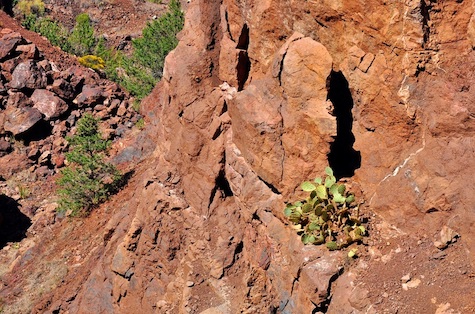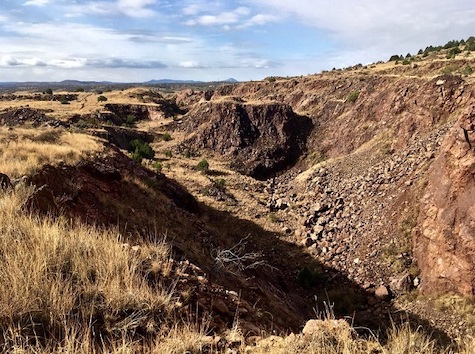The Chronicles Of Grant County
Boston Hill
 A cactus is seen growing on an outcropping at Boston Hill Open Space in October of 2012. (The photograph was provided by Steve Douglas through Flickr.
A cactus is seen growing on an outcropping at Boston Hill Open Space in October of 2012. (The photograph was provided by Steve Douglas through Flickr.
Mining companies and railroads were critical elements in the early growth of Silver City and Grant County. One such entity was the Massachusetts and New Mexico Mining Company. Headquartered in Boston, Massachusetts, this business entity encouraged folks in the Bay State and beyond to consider investing in mining operations just outside of what was then the beginnings of Silver City.
"A Chance For a Fortune" was the headline for a small news article in The Boston Globe on April 20, 1879. The newspaper reported that "Bonanza-hunters should give careful attention to the prospectus of the Massachusetts and New Mexico Mining Company, which was founded just a month ago. Their silver mine is within a quarter of a mile of Silver City, New Mexico, a growing town…"
According to a document from the Town of Silver City from Joseph Gendron titled as "Boston Hill Mining History Overview," "Boston Hill is a series of three hills that lay at the southeastern extremity of the Silver City range immediately southwest of Silver City. The first mining in the area occurred in the early 1870's after considerable prospecting for silver. The silver ore, however, did not occur in significant quantities as compared to the neighboring districts at Chloride Flats and Fleming Camp. The hills came to be called Boston Hill around 1880 after the Massachusetts and New Mexico Mining Company (also known as the 'Boston Company') purchased the Legal Tender claim. By 1883, the Company was in financial trouble and the mine changed hands once again, but not before adding an eastern name to this western town."
Reports indicated that beyond silver, the main item mined on Boston Hill was manganiferous iron ore.
A document from the State of Utah Division of Oil, Gas and Mining, also from Joseph Gendron, then the Brownfields Coordinator of the Town of Silver City, noted that "The completion of the Silver City, Deming and Pacific railroad in 1883 allowed for the transportation of heavy machinery and construction of two smelters. These operated until 1907 and by 1914 the mining of silver ore ceased in the area. The mining of manganiferous iron ore on Boston Hill commenced in 1916 with the ore shipped to Pueblo, Colorado for smelting."
The mining of manganiferous iron ore at Boston Hill was considered an important part of the efforts of the U S military to wage battle during World War I. According to a news article dated May 7, 1920, in The Deming Headlight, the "extensive Boston Hill manganese properties…[were operated] during the war [World War I]…on a big scale over a period of 18 months or longer…" The wartime contract for this ore referenced by the newspaper was with the United States Steel Corporation.
On July 24, 1920, Engineering and Mining Journal detailed that a large tonnage of manganiferous iron ore was shipped from Boston Hill in June of 1920. The publication noted that "they were without cars [train cars] for eleven days because of the washout on the Santa Fe [Railroad] line near San Marcial." This edition of Engineering and Mining Journal indicated that the railroad was to construct "a new ore-loading platform to accommodate this business."
The value of mining lands can be viewed through prices paid for ground in the area. According to a news article dated April 11, 1923, in the Santa Fe New Mexican, the "Boston Hill manganese property [was] sold to [an] eastern company for $300,000." To put that price into perspective, the U S Bureau of Labor Statistics estimated that $300,000 in April of 1923 would equate to $4,551,372.78 (can't forget those 78 cents) in May of 2020, the most recent time period for comparisons.
According to The Deming Headlight in its edition dated September 14, 1923, "5,000 tons of manganese from Boston Hill [were] shipped to Pueblo [Colorado]" during a recent week. (The specific week was not specified.)
"World War II saw a peak in manganiferous iron ore production of 86,000 long tons grading out at 13% manganese and 37% iron," according to the document from the State of Utah Division of Oil, Gas and Mining, from Joseph Gendron, then the Brownfields Coordinator of Town of Silver City. "Production after World War II was sporadic and ended in the late 1970's…"
This document also indicated that an "archeological survey performed by the Town [of Silver City]…identified 13 vertical shafts, 55 open cuts, 383 prospects and 123 waste rock concentrations."
Today, much of what was once part of this key mining district in Grant County is now included in the Boston Hill Open Space.
The Town of Silver City started purchasing land to create the Boston Hill Open Space in 1999. Funds to purchase the initial acreage came from monies left to the Town by Lennie Merle Forward; reportedly, that purchase included 462 acres. Through the years, additional acreage has been added to this passive recreational site. Several governmental entities on the local, state, and federal levels have assisted with transforming the former mining area into a public open space through funding and technical assistance. Volunteers from throughout Grant County have assisted with the formation and maintenance of this open space.
Boston Hill Open Space is noted for its trails for hiking and biking as well as for scenic overlooks of Silver City and beyond.
The Town of Silver City maintains trailheads on Cooper Street, Cheyenne Street, Spring Street, and Market Street. "The trails range from level ground to moderately rugged inclines," according to a statement from the Town of Silver City. "Many of the trails intersect, offering a range of paths through the area, and the hill's ravines and secluded valleys are terrific spots for a 'remote' picnic just a few hundred yards from Silver City's heart. A historic narrow-gauge railroad bed crosses the trail area along much of its southern third, entering the trails area near the Market Street trailhead and exiting it near the Cooper Street trailhead after a winding course of about two miles."
While no humans live at Boston Hill, there are a number of critters that call this open space home. According to a report from the New Mexico Energy, Minerals and Natural Resources Department, local residents include barn owls, bats, bobcats, coyotes, deer, javelinas, and porcupines, among other animals. You may come across one of these critters as you hike or bike the trails of this former mining district.
 This was the view of Boston Hill in December of 2017. (The photograph was provided by Joseph Reeves through Flickr.)
This was the view of Boston Hill in December of 2017. (The photograph was provided by Joseph Reeves through Flickr.)
This was the view of Boston Hill in December of 2017. (The photograph was provided by Joseph Reeves through Flickr.)
Do you have questions about communities in Grant County?
A street name? A building?
Your questions may be used in a future news column.
Contact Richard McDonough at chroniclesofgrantcounty@mail.com.
© 2020 Richard McDonough